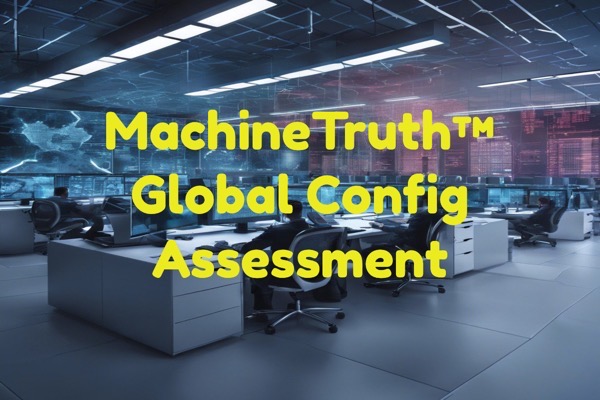Explanation of PCI-DSS requirement 1.1.7
The process for reviewing firewall, router, and network device configurations and rule sets every six months involves several steps to ensure compliance with PCI DSS Requirement 1.1.7 and maintain network security controls and router configuration standards.
Organizations can effectively conduct these reviews by utilizing services such as MachineTruth™ Global Configuration Assessments to analyze the configuration settings of firewalls, switches, routers, applications, and other network devices. By conducting regular audits and involving key personnel from the IT and security teams in the review of the results, organizations can ensure that their network device configurations and rule sets comply with PCI DSS Requirement 1.1.7 and maintain strong network security controls.

Conequences for failing to meet PCI-DSS 1.1.7
Compliance with PCI-DSS is crucial for maintaining the security and integrity of sensitive payment card information. Failing to meet the requirements of PCI-DSS can have significant implications for a company, including legal and financial consequences.
One specific requirement of PCI-DSS is 1.1.7, which addresses the need to test security systems and processes regularly. Failing to comply with this specific requirement can result in severe penalties, including hefty fines and potential legal action. Companies may also face damage to their reputation and loss of customer trust. In some cases, non-compliance with PCI-DSS requirements may lead to the inability to process payment card transactions, causing significant operational disruptions. Ultimately, the consequences of failing to meet PCI-DSS 1.1.7 can have far-reaching impacts on a company’s bottom line and long-term viability. Therefore, businesses must prioritize and invest in maintaining compliance with PCI-DSS to avoid these detrimental consequences.
Importance of securing inbound traffic
Securing inbound traffic is critical for maintaining the cardholder data environment’s security and integrity, as PCI DSS Requirement 1.2.1 mandates. Organizations can effectively prevent unauthorized access and potential security breaches by limiting inbound and outbound traffic to only what is necessary for the cardholder data environment. Traffic restrictions are crucial in controlling and monitoring data flow into the network, ensuring that only authorized and necessary sources and protocols are allowed entry. This helps to minimize the risk of unauthorized access and potential security breaches, as any unnecessary or unauthorized traffic is blocked from entering the network. By implementing and enforcing these traffic restrictions, organizations can significantly reduce the likelihood of data breaches and maintain compliance with PCI DSS standards. Therefore, organizations must prioritize and effectively secure their inbound traffic to safeguard their cardholder data environment.
Importance of securing outbound traffic
Securing outbound traffic is paramount for protecting an organization’s sensitive information and preventing potential risks such as data breaches, exposure to malware, and unauthorized access to critical data. Unsecured outbound traffic can lead to data leaks, theft of intellectual property, and compromise of confidential information, causing significant financial and reputational damage to the organization.
Implementing egress filtering, encryption, data loss prevention, and threat detection measures can help mitigate and/or minimize these risks. Egress filtering is the single most powerful tool in preventing data exfiltration. By implementing best practices around all network traffic leaving the network or segments, most data exfiltration can be disrupted. Encryption ensures that data transmitted outside the organization’s network is securely ciphered, preventing unauthorized access and data breaches. Data loss prevention tools enable organizations to monitor and control the transfer of sensitive data, thereby reducing the risk of data leaks and unauthorized access. In addition, threat detection methods allow real-time visibility into outbound traffic, enabling prompt detection and response to unauthorized or malicious activities.
By securing outbound traffic through these measures, organizations can significantly reduce the likelihood of data breaches, exposure to malware, and unauthorized access to sensitive information, thus safeguarding their critical assets and maintaining the trust of the card brands and customers.
Description of MachineTruth Global Configuration Assessment capabilities
This assessment leverages MicroSolved’s proprietary analytics and machine learning platform, MachineTruth, to review device and application configurations in mass at a global scale. The assessment compares device configurations against industry standard best practices, known vulnerabilities, and common misconfigurations. It also allows organizations to ensure control homogeny across the enterprise, regardless of using different vendors, products, and versions.
Adopted security standards and security policies can be used as a baseline, and configurations can be compared holistically and globally against these universal security settings. Compensating controls can be identified and cataloged as a part of the assessment if desired.
Various analytics can also be performed as a part of the review, including trusted host hierarchies, reputational analysis of various sources for configured rules and access control lists, flagging of insecure services, identification of deprecated firmware, log management settings, protocols, encryption mechanisms, etc. MachineTruth can hunt down, flag, and provide specific mitigation and configuration advice to ensure these issues are fixed across the enterprise, architectures, and various vendor products.
If needed, the MachineTruth platform can verify network segmentation and serve as proof of these implementations to reduce the compliance scope to a subset of the network and data flows.
How MachineTruth helps organizations meet PCI requirements
MachineTruth Global Configuration Assessments help organizations simplify the process of meeting PCI-DSS 1.1.7 and other relevant regulatory requirements. By working across vendor platforms, and reviewing up to several thousand device configurations simultaneously, even the most complex networks can be reviewed holistically and quickly. Work that would have taken several man-years to perform with traditional methods can be accomplished quickly and with a minimum of resources.
Multi-level reporting also provides for an easy, prioritized path to mitigation of the assessments, and if you need assistance, MicroSolved’s extensive partner network stands ready to help you make the changes across the planet. The output of the assessment includes technical details with mitigations for each finding, a technical manager report with root causes, and suggestions for improvement across the enterprise, as well as an executive summary report that is designed to help upper-level management, boards of directors, auditors, and even business partners performing due diligence, understand the assessment outcome and the state of security throughout the organization’s networks. The reporting is excellent for establishing the true state of network compliance, even on a global scale.
This not only allows organizations to easily and rapidly meet PCI-DSS 1.1.7, but also allows them to quickly harden their networks and increase their security posture at a rate that was nearly impossible in the past. Leveraging the power of AI, machine learning, and analytics, even the most complex organizations can make solving this compliance problem easy.
How to Engage with MicroSolved, Inc.
To learn more about a MachineTruth Global Configuration Assessment or the 30+ years of security expertise of MicroSolved, Inc., just drop us a line at info@microsolved.com. You can also reach us at +1.614.351.1237. Our team of experts will be more than happy to walk through how the platform works and discuss the workflow and costs involved with this unique option for meeting PCI requirements and other relevant regulatory guidance. While MicroSolved is a small firm with more than 30 years in business, some clients prefer to work through our larger partners who are likely already on established vendor lists. This is also possible, and the protocols and contractual arrangements are already in place with a number of globally recognized professional services firms. Whether you choose to work with MicroSolved directly, or through our partner network, you will receive the same excellent service, leading-edge insights and benefit from our proprietary MachineTruth platform.


